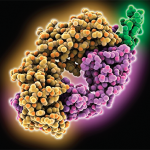 NEW YORK (Reuters Health)—Long-term rituximab use lowers the chance of relapse of anti-neutrophil cytoplasmic antibody (ANCA) associated vasculitis (AAV), compared with standard maintenance therapy, according to a report from the MAINRITSAN3 randomized trial.
NEW YORK (Reuters Health)—Long-term rituximab use lowers the chance of relapse of anti-neutrophil cytoplasmic antibody (ANCA) associated vasculitis (AAV), compared with standard maintenance therapy, according to a report from the MAINRITSAN3 randomized trial.
“Physicians should consider AAV to be a long-lasting, chronic disease which requires maintenance therapy,” says Dr. Pierre Charles of Cochin Hospital, Paris Descartes University, and Institut Mutualiste Montsouris, Paris.
“Many patients (e.g., patients who already experienced a relapse, patients with anti-PR3-ANCA) should receive at least 4 years of maintenance therapy, but this maintenance therapy could be extended,” he tells Reuters Health by email.
The earlier MAINRITSAN trial demonstrated clear superiority of rituximab over azathioprine for maintaining remission in patients with AAV. Both the U.S. Food and Drug Administration and the European Medicines Agency recommend rituximab 500 mg on days 0 and 14 and then at months 6, 12 and 18 to maintain AAV remission.
In the MAINRITSAN3 trial, Dr. Charles and colleagues evaluated the efficacy of prolonging the rituximab infusion schedule another 18 months to maintain remission in patients who achieved complete remission after the first phase of rituximab maintenance therapy.
The 50 patients assigned to rituximab received a 500-mg fixed dose of rituximab intravenously at randomization and at months 6, 12 and 18. The 47 patients assigned to the control group received placebo at the same times.
Relapse-free survival at 28 months, the primary endpoint, was 96% in the rituximab group vs. 74% in the placebo group, a significant difference, the researchers report in Annals of Internal Medicine.1
Six patients in the placebo group (vs. none in the rituximab group) had major relapses, received a new induction regimen with high-dose glucocorticoids and rituximab, and achieved remission.
The two groups did not differ significantly in Vasculitis Damage Index scores at the end of the trial or in quality-of-life outcomes over the course of the study.
Cumulative mean glucocorticoid doses after randomization did not differ significantly between the groups, and at the end of the trial 39% of patients in the rituximab group and 50% of patients in the placebo group were still receiving glucocorticoids.
Adverse event and serious adverse event rates did not differ significantly between the rituximab and placebo groups.
“The prolongation of maintenance therapy with rituximab 500-mg fixed-dose every six months for four years is efficient and should be considered in AAV patients,” Dr. Charles concludes.
He adds, “Some questions remain unanswered: should we treat all AAV patients with extended rituximab therapy or should we propose this new strategy to an AAV population considered at high risk of relapse? The optimal duration of maintenance therapy is not yet determined (and it will not be easy to answer this question in a trial), but we can think that some patients require very-long-term rituximab therapy.”
Dr. Gary S. Hoffman of Cleveland Clinic, who wrote an editorial related to this report, tells Reuters Health by email, “In the setting of a patient with granulomatosis with polyangiitis (GPA) or microscopic polyangiitis (MPA), who has already experienced numerous relapses or has accumulated damage from vasculitis (e.g., chronic renal failure or severe lung injury, etc.), whose disease, if uncontrolled, is likely to cause further profound disability or death, extreme caution is advised before discontinuing any form of successful, well-tolerated therapy, including rituximab.”2
“However, for lower-risk patients, we do not know the risk-benefit odds of indefinite rituximab treatment versus cautiously monitoring for and treating early signs of relapse,” he said. “For those patients, if a long-term remission occurs after several rituximab infusions, at this time, it may be safest to carefully monitor off treatment and treat for the earliest signs of relapse.”
Dr. Chetan Mukhtyar of Norfolk and Norwich University Hospital, Norwich, U.K., co-authored the European League Against Rheumatism (EULAR)/European Renal Association-European Dialysis and Transplant Association (ERA-EDTA) recommendations for the management of ANCA-associated vasculitis. He tells Reuters Health by email, “The implications [of the findings] are two-fold: firstly, I think we should try and use lower doses of rituximab for remission maintenance. On both sides of the Atlantic, we have been using 1 g pulses every six months, and this firmly proves that 500 mg will do the trick.”
“Secondly, we should use rituximab for longer than the two years that we currently do,” he says. “Especially in the U.K., the authorities will have to sit up and take notice. Currently the funding approval for rituximab maintenance is only available for patients who have a relapse after initial rituximab induction. Which means that there is no remission-maintenance treatment after the 1st rituximab induction.”
“I think this report needs revalidation, like all good science,” says Dr. Mukhtyar, who was not involved in the study. “But after this, we should be using less rituximab, but more regularly and for longer.”
The study was funded by research grants from the French Ministry of Health and from Hoffman-La Roche, which also provided rituximab for the study.
References
- Charles P, Perrodeau E, Samson M, et al. Long-term rituximab use to maintain remission of antineutrophil cytoplasmic antibody-associated vasculitis: A randomized trial. Ann Intern Med. 2020 Jun 2. Online ahead of print.
- Hoffman GS. Vasculitis: Again, changing the standard of care. Ann Intern Med. 2020 Jun 2. Online ahead of print.

